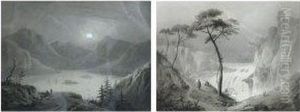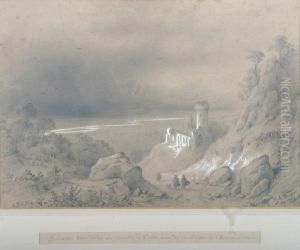Francois Alexandre Pernot Paintings
Francois Alexandre Pernot was a French painter and lithographer known primarily for his genre scenes, landscapes, and historical paintings. Born in 1793 in France, Pernot's artistic journey began at a time when the Neoclassical movement was giving way to Romanticism, and his work would reflect the transition between these styles, capturing both the precise linearity of Neoclassicism and the emotional expressiveness of Romanticism.
Pernot trained under influential artists of the time, such as Anne-Louis Girodet and Antoine-Jean Gros, both pupils of the famed Neoclassical painter Jacques-Louis David. Through this lineage, Pernot became adept in the techniques and ideological underpinnings of Neoclassical art. Despite this, he also drew inspiration from the burgeoning Romantic movement, which emphasized the sublime beauty of nature, emotion, and the individual.
Throughout his career, Pernot exhibited his work at the prestigious Paris Salon, the official art exhibition of the Académie des Beaux-Arts in Paris. His contributions to French art were recognized by his contemporaries, but he did not achieve the same enduring fame as some of his peers.
Pernot's lithographs and paintings often depicted the French countryside, historical events, and scenes from daily life. His work is characterized by its attention to detail and a certain sentimental quality that appealed to the tastes of the middle class of the time. His landscapes show a sensitivity to the natural world that is typical of Romantic sensibilities, while his genre scenes are often imbued with a narrative element that invites the viewer to engage with the depicted moment.
Although not as widely known today as some of his contemporaries, Pernot's contributions to French art during a period of significant transition are still appreciated by art historians and collectors. His works can be found in several museums and private collections, offering insights into the cultural and artistic milieu of early 19th-century France. Francois Alexandre Pernot passed away in 1865, leaving behind a legacy of work that captures an important era in French art.









